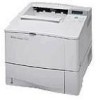HP 4100n HP LaserJet 4100 Series - User Guide - Page 83
Printing a job, PROCESSING JOB
 |
View all HP 4100n manuals
Add to My Manuals
Save this manual to your list of manuals |
Page 83 highlights
Note Note 3 Change PostScript Printer Description (PPD) File to match the printer. 4 On the File menu, select Save. 5 Enter a name and location for the desktop printer icon and click OK. Once the icon is on the desktop (or saved elsewhere), printer options need to be manually configured. This step is essentially the same as selecting Configure after setting up a printer in the Chooser. To set the options, highlight the Desktop Printer icon and select Change Setup from the Printing menu. Printing a job 1 Align your laptop computer (or other portable device equipped with an IRDA-compliant FIR window) within 1 meter (3 feet) maximum of the HP Fast InfraRed Receiver. The FIR window must be at an angle of within +/- 15 degrees relative to the printer to ensure an effective connection for printing. 2 Print the job. The status indicator on the HP Fast InfraRed Receiver lights up, and, after a short delay, the printer status panel displays PROCESSING JOB. If the status indicator does not light up, realign the HP Fast InfraRed Receiver with the FIR port on the sending device, resend the print job, and maintain the alignment of all devices. If you have to move the equipment (for example, to add paper), make sure that all devices remain within the range of operation to maintain the connection. If the connection is interrupted before your print job is complete, the HP Fast InfraRed Receiver status indicator turns off. You have up to 40 seconds to correct the interruption and continue the job. If the connection is resumed within this time, the status indicator lights up again. The connection is permanently broken if the sending port is moved out of operating range or if anything passing between the ports blocks transmission for more than 40 seconds. (This block could be a hand, paper, or even direct sunlight.) Depending on the size of the job, printing with the HP Fast InfraRed Receiver may be slower than printing with a cable connected directly to the parallel port. EN Printing with the optional HP Fast InfraRed Receiver 81















